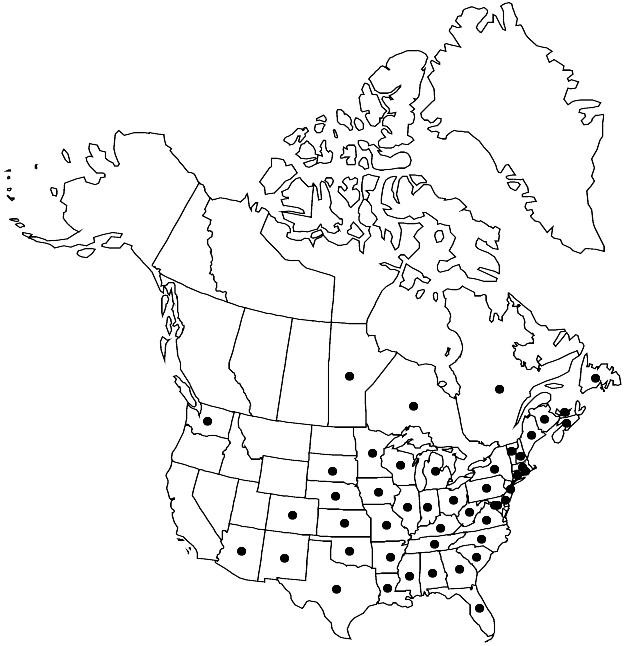Anomodon attenuatus
Muscol. Germ., 562. 1833.
Plants large, in dense mats, yellowish green. Stems 1.5–3 cm, 0.8–1 mm thick when dry, profusely branched, irregularly pinnate, primary branches prostrate to arcuate, mostly attenuate, secondary branches attenuate at apices; central strand cells not differentiated; pseudoparaphyllia absent; rhizoids somewhat abundant. Branch leaves appressed when dry, complanate when moist, ligulate, slightly narrowed mid leaf, 1.2–2 (–2.2) mm; base broadly decurrent; margins plane, entire from base to apex (cells moderately mammillose at insertion), sometimes denticulate near apex; apex acute, sometimes obtuse or slightly apiculate, intact; costa strong, sharply ending a few cells before apex, sometimes fading in youngest leaves, not obscured by laminal cells distally, pellucid, abaxial costa cells smooth; basal laminal cells hyaline or sometimes chlorophyllose, papillae few, region sometimes extending more than 1/2 length of leaf base; distal cells quadrate, 6–8 µm, papillae many, branched. Perichaetia never beyond last branching points, leaves abruptly narrowed, costa to beyond mid leaf, ending near apex in most interior leaves, laminal cells smooth. Seta 1–1.5 cm. Capsule oblong, urn 1.6–2.8 mm; stomata at base; annulus not differentiated; operculum obliquely short-rostrate, 1.3 mm; exostome teeth irregular, 0.3 mm, striolate proximally, trabeculate and ± finely papillose towards apex; endostome basal membrane 3 or 4 cells high, segments well developed. Spores 10–13 µm, densely papillose.
Phenology: Capsules mature early-mid fall.
Habitat: Tree bark, at base, soil, rock
Elevation: low to moderate elevations
Distribution

Man., N.B., Nfld. and Labr. (Nfld.), N.S., Ont., P.E.I., Que., Ala., Ariz., Ark., Colo., Conn., Del., D.C., Fla., Ga., Ill., Ind., Iowa, Kans., Ky., La., Maine, Md., Mass., Mich., Minn., Miss., Mo., Nebr., N.H., N.J., N.Mex., N.Y., N.C., Ohio, Okla., Pa., R.I., S.C., S.Dak., Tenn., Tex., Vt., Va., Wash., W.Va., Wis., Mexico, West Indies (Cuba), West Indies (Hispaniola), West Indies (Jamaica), Central America (Belize), Central America (Guatemala), Europe, Asia (India), Asia (e Russia), Asia (Turkey)
Discussion
Anomodon attenuatus is a rather polymorphic species producing abundant sporophytes in North America. The attenuate branches, sometimes arcuate and seldom ascending, are distinctive. However, this character is sometimes lacking; in some specimens the branch apices become slightly capitate and incurved. Robust plants of A. attenuatus might be mistaken for those of A. viticulosus as both have acute leaf apices. They can be distinguished by their branch morphology: prostrate and complanate in A. attenuatus, ascending and robust in A. viticulosus. Also, the leaf shape is different in both species: lanceolate and with no constriction in A. attenuatus, broadly ligulate, abruptly narrowed from a broadly ovate base in A. viticulosus. The costa in A. attenuatus also lacks the thick, aligned papillae on the dorsal surface. A consistent character in fertile plants is the absence of gametangia beyond the most recent branching points (they are never formed in the youngest branches). The branching pattern is often of several orders of successive branching, in stepwise fashion; the endostome is papillose.
Selected References
None.